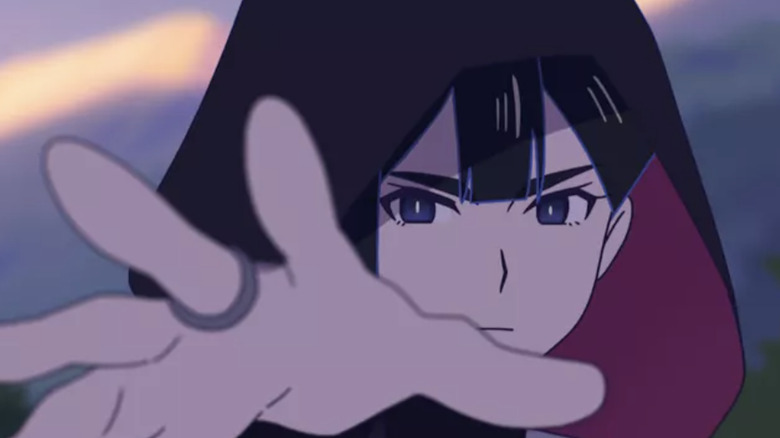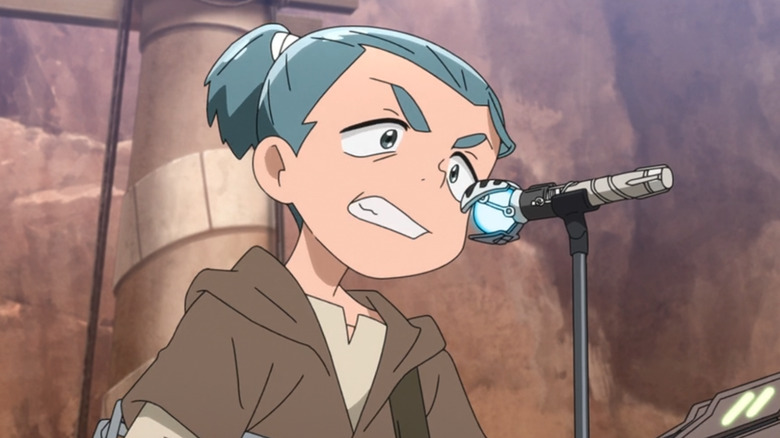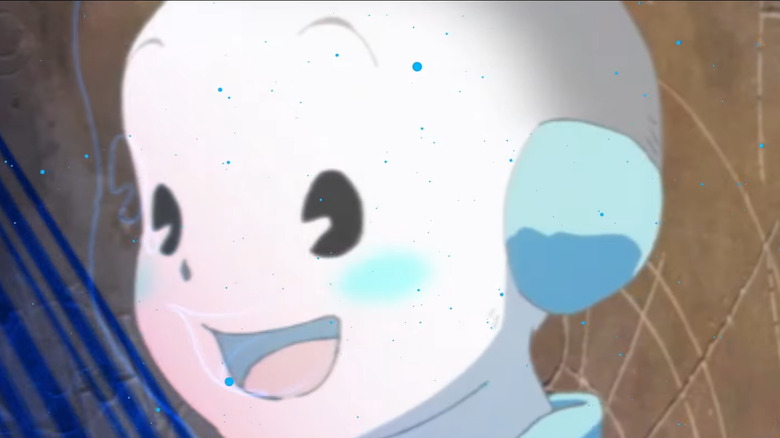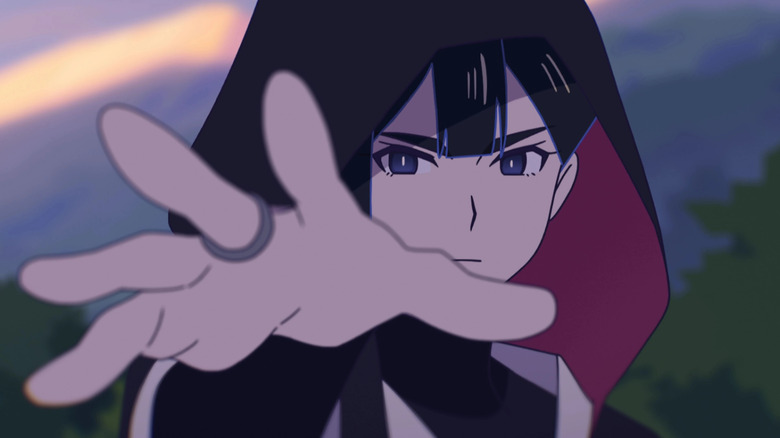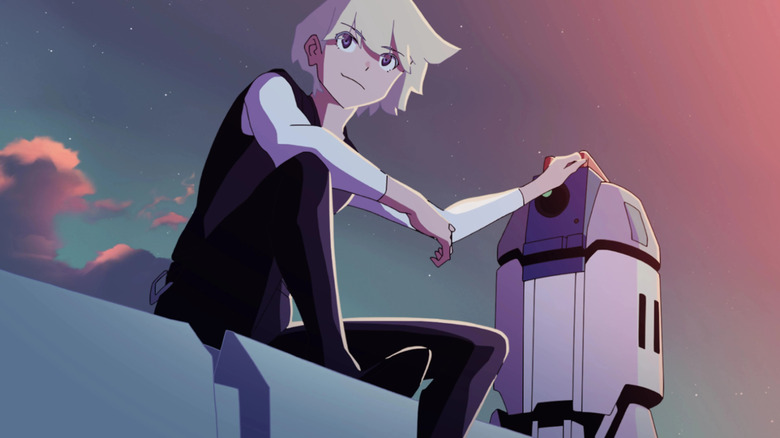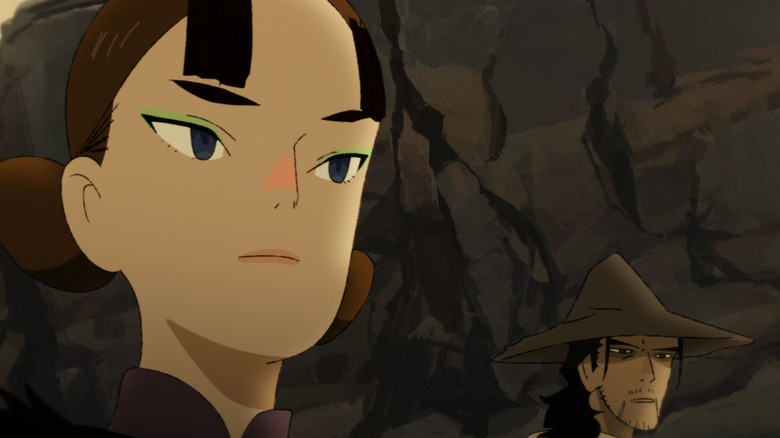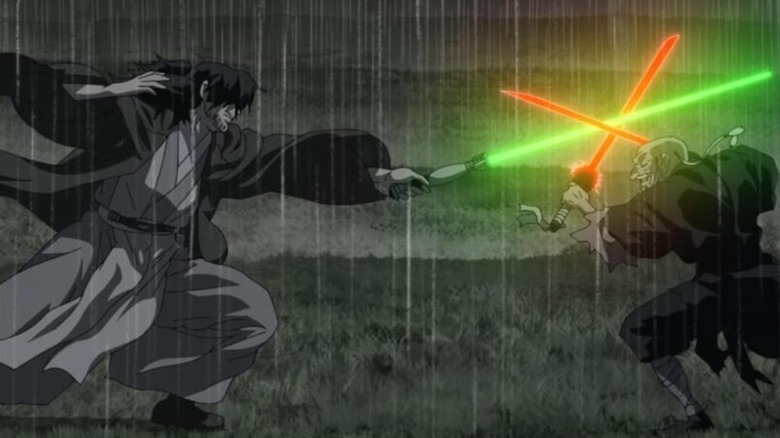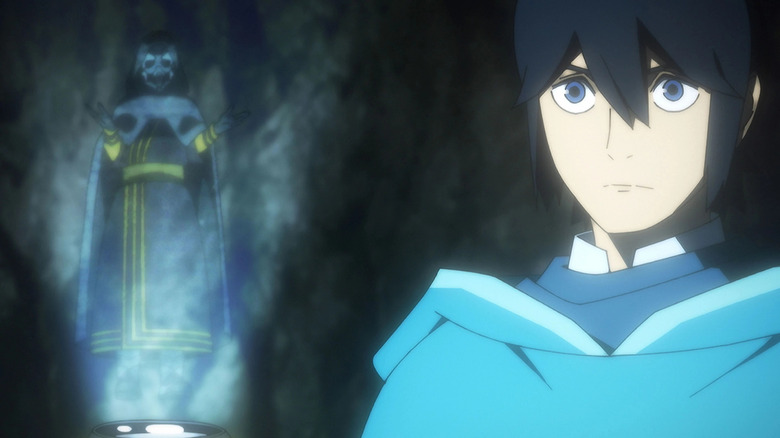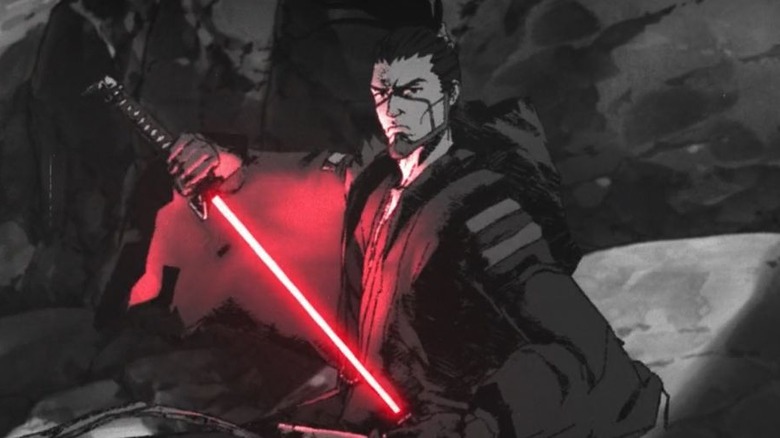Every Star Wars: Visions Short Ranked
"Star Wars: Visions" isn't just one of the most exciting pieces of "Star Wars" media to come out in the last decade, it's also one of the few things that critics and fans agree is great. The concept of bringing together a group of anime's top creators to tell their own "Star Wars" stories was a big idea, and one that has paid off, not just for Disney but for fans as well. The nine shorts (on Disney+) are each visually and narratively distinct, even those created by the same studios (Trigger and Science Saru contributed two shorts each). Also refreshing: A number of the studios took full advantage of the opportunity to create stories in the "Star Wars" universe that are not beholden to existing canon.
Like any anthology, though, the shorts vary in quality. Some of the narratives feel more original than others, some of the animation styles feel exciting while others are more standard — and in some cases, the shorts are truly like nothing we've seen before in animation or "Star Wars." While every one of the shorts is worth watching, and they all have something unique to offer the "Star Wars" universe, some are worth a higher recommendation than others. As such, below is every "Star Wars: Visions" short, ranked in "must-watch" order.
9. Tatooine Rhapsody
Studio Colorido's "Tatooine Rhapsody" lands in an awkward place among the nine "Visions" shorts. It's simultaneously one of the most original "Star Wars" stories ever committed to screen, and the short that leans the most on existing "Star Wars" characters. Both of those aspects lead to it being the weakest among the group.
The story focuses on a band, trying to make it big in the galaxy but with a pesky bounty hunter on their trail. That bounty hunter isn't just anybody, it's Boba Fett (Temuera Morrison reprising his role), sent to bring back band member Geezer (Bobby Moynihan) for execution by Jabba the Hutt. This strange mix of focusing on musicians (a first for a "Star Wars" story) while also being a classic Boba Fett bounty hunting story ultimately feels as though "Tatooine Rhapsody" is leaning too heavily on tried-and-true adventures from the galaxy far, far away; what's worse, the stakes feel inconsequential to the overall universe.
Overly cute in both its emotional beats and animation, all of the characters in "Rhapsody" are chibi; the short is brightly lit, and there are barely any angles among the many curved lines of the character and set designs. There's an emotional reminiscing scene when the band decides that they can't leave one of their own behind, which is a valid story beat, but doesn't quite work in a 13 minute short that hasn't allowed the audience to develop any real affinity towards these characters. Perhaps most significantly, the episode ends with a full-on musical number, one that's sickly sweet with its soaring melodies and "be yourself" chant — it might just be the most grating Star Wars musical performance since Bea Arthur.
Even if some viewers did enjoy the song, it takes up a full two minutes of the short — which is nearly a sixth of its run time — at the expense of possibly more interesting developments.
8. T0-B1
Science Saru's "T0-B1" has some similar issues with "Tatooine Rhapsody," being a bit too cute for its own good. Its lead character, the titular droid (Jaden Waldman), looks like a "Star Wars" version of Astro Boy whose surroundings (and creator/caretaker Mitaka, voiced by Kyle Chandler) are every bit as brightly lit, smoothly drawn, and too glossy for its own good as those in "Tatooine Rhapsody."
What "T0-B1" has going for it, however, is that it's a stronger story than "Rhapsody," at least in terms of characters. Its simple plot hits intriguing story beats, as T0-B1 dreams of being a Jedi (the short's strongest sequence is a gorgeously animated dream/vision sequence of what T0-B1 imagines life as a human Jedi would be like), and in a moment of rebellious hubris sends out a call to Jedi in the galaxy. This call is picked up by the Empire, who immediately dispatch an Inquisitor to assassinate whoever made the call; when Mitaka is killed by the Inquisitor, T0-B1 becomes determined to avenge his creator.
While all this is reminiscent of Obi-Wan being struck down by Vader before Luke takes him on, it manages to feel like an homage, rather than a mere retread. A significant part of this distinction is that T0-B1 is a droid, making this perhaps the first time in "Star Wars" lore that audiences have been presented a droid worth aspiring to be, perhaps one that could even succeed in becoming a Jedi Knight. It also helps that the short includes some surprisingly brutal action, particularly in T0-B1's showdown with the Inquisitor.
7. Lop & Ochō
Like "T0-B1," Geno Studio's "Lop & Ochō" gets immediate points for being a "Star Wars" story that focuses on a non-human main character. It also benefits from focusing on a main character who isn't a droid but a wholly-original "Star Wars" species: Lop (Anna Cathcart) is a Lepi, a humanoid alien with the fur, large eyes, and long floppy ears of a rabbit.
The story focuses on the relationship between Lop and her adoptive sister Ochō (Hiromi Dames), who along with her father Boss Yasaburō (Paul Nakauchi) took Lop in when she was a child. Like many of the other shorts, "Lop & Ochō" takes place during the imperial era, as the Empire invades and begins to take over the characters' home planet of Tao. Boss Yasaburō seeks to organize a rebellion against the Empire, whose industrial expansion is harming the planet, but Ochō seems more interested in joining them, and Lop is caught between her father and sister.
These are classic "Star Wars" themes, but the smaller scale of the story, its focus on the relationships between the characters, and the fact that Lop isn't human makes it feel unique. The animation here is also beautiful, as much of the backgrounds and character designs are inspired by feudal Japanese aesthetics. This aesthetic comes to a perfect point when Boss Yasaburō gifts Lop a familial lightsaber that includes an inscription on the blade like a katana might have, but unlike anything we've seen in the "Star Wars" universe before. The finale of "Lop & Ochō" falls into some overly dramatic monologues, but this is where the truly transcendent shorts begin in this anthology.
6. The Village Bride
Kinema Citrus's "The Village Bride" expands on the light environmental themes in "Lop & Ochō," introducing the notion that a planet itself can have memories. This idea, and other aspects of the short, are reminiscent of the work of Hayao Miyazaki, particularly more action-oriented films like "Nausicaä of the Valley of the Wind" and "Princess Mononoke."
These films come to mind in the loving way that natural landscapes and plant life are drawn and shown in "Village Bride" — as well as some not-so-subtle dialogue about the indigenous people's respect for nature, the exploitation of their planet by invading forces throughout the years, and how war is overwhelmingly the cause for such exploitation. But those themes and ideas don't need to be subtle, making "The Village Bride" perhaps the most thematically expansive of the "Visions" shorts.
Naturally, the animation doesn't quite live up to the standard of Miyazaki. While the story allows for the interesting (if blunt) conversation-starters mentioned above, at times it feels too melodramatic to be taken seriously. As "Village Bride" follows two visitors to a planet who decide to save a village from bandits demanding collateral in the form of the village chief — causing the chief's granddaughter to go in his place following her wedding — the proceedings become drama without depth.
5. The Twins
Trigger is the studio behind the recent smash hit "Promare," and it's easy to see that in the animation of "The Twins." In fact both "Promare" and "The Twins" are directed by celebrated director Hiroyuki Imaishi, so it makes sense that he brings the eye-popping mix of 2D and 3D that made "Promare" such a hit to his "Visions" entry.
Like that feature, however, this short is mired in awkward exposition, yielding a first half of the short that too often spends its time filling viewers in on the premise. There's some interesting stuff here, to be sure — like the idea of twins who are created through the power of the dark side — but a lot of it feels unnecessary and confused. At least the English dub has Allison Brie delivering most of this exposition with relish, as one of the two twins who has fully accepted and embraced her role as a servant of the dark side.
The conflict of the short arises between the titular twins as Karre (Neil Patrick Harris) decides to leave the dark side behind in favor of the light, while Am (Brie) stays loyal. Once this conflict is established, the short becomes a major battle between the two, and a visual feast. It delivers the most in-your-face, over the top anime intensity of any of the "Visions" shorts via bright light flashes, fast moving speed lines, and gorgeous use of color. It's almost overwhelming how much visual information is packed into each frame of the fight, and the result is a delight to behold.
4. Akakiri
One of the most intriguing aspects of the "Visions" shorts is that even though a few were made by the same studio, they are entirely different from one another. "Akakiri" not only looks wholly distinct, but offers a very different story from Science Saru's other short, "T0-B1."
"Akakiri" feels more like a high-fantasy short story than a "Star Wars" story, but that's a good thing as it feels unique. The tale follows Jedi Tsubaki (Henry Golding), who has returned to his home planet to help the royal family in their fight against Sith Lord Masago (Lorraine Toussaint), who also happens to be the king's sister. When he arrives, he meets exiled princess Misa (Jamie Chung) — who he seems to have a history with — as well as the guides who are leading her back to her old palace so that she can attempt to take it back. The short follows their journey through a variety of landscapes and through their assault on the palace, presently under Sith control.
It's a simple story, but what makes it one of the best of the shorts is the stunning animation throughout. The journey through all the different landscapes, from deserts to forests, is breathtaking in each environment because of the watercolor-esque techniques employed to capture the environments; their beauty is only highlighted by the simple silhouettes of our heroes passing through them. The final battle between Tsubaki and Masago isn't just a great piece of lightsaber duel action, but is one of the most unique, bewitching "Visions" moments, as their lightsabers give off light trails along with the more common motion blur and light pollution.
3. The Elder
Like the Science Saru shorts, the two Trigger shorts look entirely different from one another. Where "The Twins" gets a bit bogged down in its big exposition dumps, "The Elder" is wonderfully simple.
This short follows Jedi Master Tajin Crosser (David Harbour) and his padawan Dan (Jordan Fisher) who detect a disturbance in the Force during their patrol of the Outer Rim. They investigate the nearest habitable planet, learning an elder from a tribe unknown to the inhabitants of the planet recently arrived and ventured into the mountains near their village. Tajin and Dan decide to split up, allowing Tajin to check out the elder's ship and await his return, while Dan explores the mountains. Dan discovers the elder (James Hong) first, and the elder immediately attacks him with his dual red lightsabers. As they battle, the elder tells Dan that he was hoping for a challenge and Dan isn't living up to his hopes. He strikes Dan down, but does not kill him — then awaits Tajin's arrival, who more than lives up to his hopes.
Both duels are short, yet fantastically choreographed and animated; they feel tactile, and the blows between the lightsabers seem to have real force (no pun intended) behind them. In the second duel, between the elder and Tajin, the elder uses force lightning that crackles beautifully in the rain. But the short also looks fantastic during its calmer moments, as the landscapes of the planet look impressionistic and the Jedi look more like Samurai than usual.
This "Visions" short also packs some interesting dialogue and ideas into its 17 minutes. At the start, Dan is eager to fight, as Tajin advises that Jedi must never seek out aggression. At the end, after their adventure, Tajin talks about time as the ultimate power, noting that it was not he, but time itself that ultimately defeated the elder. Neither of these thematic notes are incredibly potent, but they nevertheless add substantial depth.
2. The Ninth Jedi
Production I.G.'s "The Ninth Jedi" is the longest of the shorts at 22 minutes, but it's also the only one that feels like it could have been even more. That incomplete feeling is part of why it is one of the best.
The short is set farther into the future of the galaxy than any other "Star Wars" story has ever explored. The Jedi have not been a presence in the galaxy for generations, but the Margrave of a planet on the Outer Rim has begun mining for kyber crystals and has sent out a call to potential Jedi in the galaxy. A group responds to this call, arriving at an aerial temple that floats above the Margrave's planet, including a young man named Ethan (Masi Oka). Meanwhile, on the planet, young Kara (Kimiko Glenn) and her father Zhima (Simu Liu) discuss the lightsabers that he has forged, which reflect a wielder's force connection with their color.
There's a significant amount of plot in the short, so much so that it actually opens with a voiceover that evokes the opening crawls of the films, but it never feels too dense. It feels as if it's setting up a new grand adventure, one that could focus on Ethan and Kara, with a fantastic first chapter. It also boasts the best score of all the shorts, the only one to truly succeed in creating the enchanting feeling that the John Williams scores brought to the films. There is also some memorable action, not just with the multi-character lightsaber showdown finale, but also via a speeder bike chase evocative of Luke and Leia's chase through the forests of Endor in "Return of the Jedi."
Fans have already begun hoping that this short could be turned into a new series, and director Kenji Kamiyama has expressed a willingness to expand the story via TV or film. So, for now, keep those lightsabers crossed.
1. The Duel
Kamikaze Douga's "The Duel" is far and away the most stylistically unique of these shorts: it is overwhelmingly black and white, save a few hints of color in the lights of the village, blaster fire, and of course lightsabers. It's also more three-dimensional than the other shorts (many, including "The Twins," employ the technique for the interaction between ships and their environments); every character, environment, and projectile here is boldly three-dimensional.
The short is also a far more direct homage to samurai films and the aesthetics of feudal Japan than any of the other shorts. The village is styled like a Japanese one, every piece of costuming feels like it's straight out of a Kurosawa samurai film, and the overall result is so deeply reverential to feudal Japanese aesthetics that the short includes a filter adding film grain, making it resemble an old samurai movie.
The story of "The Duel," which follows a lone lightsaber wielder who comes to town and helps fend off bandits, invokes not just any samurai films, but specifically the traveling ronin films that inspired Italian and American remakes that transposed the original plots into the wild west. These movies in particular influenced George Lucas in the creation of "Star Wars," as much western as it was science fiction (indeed, much of Kurosawa's "The Hidden Fortress" served as a template for the original "Star Wars").
"The Duel" brings all of that cinematic history, and the intertextual relationships between these films and the "Star Wars" franchise, to bear on a 13 minute short. The result is a memorable adventure that elevates itself from something purely enjoyable on a visual level to a short that feels essential viewing for any "Star Wars" fan.
